When people think about carbon emissions, they probably don’t consider the soaring glass towers of our CBDs. However creating the concrete and steel so vital for construction contributes about 8% of global greenhouse gas emissions, according to the Green Building Council of Australia (GBCA).
That embodied carbon in building materials accounts for 20-25% of a typical building’s total carbon footprint over its lifetime. The rest is due to operational emissions from the power needed to light, heat and cool buildings.
Davina Rooney, the GBCA’s Chief Executive, told the Momentum conference that energy usage in buildings is just a small part of the carbon challenge. GBCA research has found that about 16% of carbon emissions are from the built environment. As the power grid shifts to renewables, however, that will become more than 85%.
Lendlease’s Mission Zero
While decarbonising won’t be easy for the construction and property sector, it doesn’t lessen its ambition, says Ann Austin, Head of Sustainability at Lendlease, an international real estate and property group.
It was an eye-opening moment in 2021 when members of the Lendlease team decided they didn’t want their children to live in a world with two or three degrees warming, she says.
“That was really a turning point for us about saying, let’s get serious about our role that we play in the sector that we are in. How do we genuinely take responsibility for that?”
The real estate and development group’s Mission Zero roadmap has a target of net-zero carbon emissions by 2025 (scope 1 & 2), just three years away, and absolute zero by 2040 (scope 1, 2 & 3). Absolute zero means eliminating all carbon emissions without the use of offsets.
It will do this by removing reliance on mineral diesel and gas in new buildings and construction activities, using 100% renewable electricity in its properties by 2030, transitioning existing properties to be all electric, and working with suppliers to eliminate embodied carbon in construction materials. It will also partner with tenants in its buildings to reduce their emissions.
Customers, too, have been pushing hard for this transition, as organisations have expectations about meeting sustainability requirements.
“We are getting surveys from our tenants asking us about our sustainability credentials,” says Austin.
A shift in energy efficiency
Powering buildings with renewable electricity, or giving them a score based on NABERS star ratings, which measure their energy consumption, are positive steps. However there is going to be a dramatic shift in energy efficiency required in the coming years, says CommBank’s Executive General Manager, Group Corporate Services Jennifer Saiz.
It will include rethinking operations to drive things like zoning of workplaces and moving people to different parts of a building to maximise efficiency.
“I think those probably are the biggest challenges; and then you get to the embodied carbon where there are data challenges and operational challenges in being able to execute that.”
There isn’t a single solution to addressing carbon in buildings, rather, it is many different things. “When it comes to operational emissions, as an architect we of course have a good understanding of what can be done – especially to reduce that energy demand from the get-go,” says Lotte Baert, Associate Partner with global architecture and design firm Foster + Partners.
Yet embodied carbon remains the big issue. “For us at Lendlease, embodied carbon is routinely more than 80% of our carbon footprint. If a customer doesn’t ask us to go into that space, that is a massively missed opportunity,” says Austin.
Smart re-use of existing spaces
New construction with passive design and lower-carbon materials isn’t the only solution for reducing carbon. Where there are good bones, it may not be best to tear down and rebuild.
Adaptive reuse, says Baert, involves thinking about ways to make your existing building more energy efficient and greener. In one case, her firm was able to refit an existing listed heritage building with a modern commercial office use, focussing on natural ventilation and skylights that reduced heat loads and improved air quality.
The refit was also completely demountable and recyclable. “Even when the client decides that maybe this isn’t right for them any more in 10 years’ time, they can take this whole system apart and recycle the materials or use them elsewhere.” In the interim, however, it’s incorporating 21st-century technologies to find energy efficiencies.
In addition to adaptive re-use, designing efficient services within any building – new or re-purposed, is essential, notes Lendlease’s Austin. “It’s beholden on us, first of all, to not need as much electricity in the first place,” she says.
However it’s also just good business.
“Electricity’s really expensive … so you’d be nuts to be buying more than you needed to,” Austin says.
Our green building experts
Ann Austin is the Head of Sustainability for Lendlease. She has worked with the group since 1992 in a variety of sustainability, project and people management roles including as CEO of the Lendlease Foundation and General Manager of Organisational Development for Bovis Lend Lease. In 2004, she established Lendlease’s first suite of sustainability metrics, guided by the Global Reporting Initiative framework.
Jennifer Saiz is Executive General Manager – Group Corporate Services for CommBank. She is responsible for leading the team managing the Bank’s property and procurement functions and is accountable for operational emissions and sustainability strategies that relate to the Group’s operations. She is also a committee member of the Green Building Council of Australia’s Green Star Advisory Committee.
Lotte Baert is Associate Partner at Foster + Partners, an international architectural firm headquartered in the UK. She holds a Master in Architecture degree from the University of Leuven in Belgium. In Australia, Lotte currently leads the project team on the Pitt Street Integrated Station Development and commercial tower (Parkline Place) above. Prior to that she completed Foster+Partners’ work on the Central Park Masterplan and the twin tower development DUO in Sydney.
Davina Rooney has been Chief Executive Officer of the Green Building Council of Australia since 2019. A qualified engineer, she has worked on large-scale projects in Sydney and London, and spent a decade driving sustainability at one of Australia’s largest diversified property companies, Stockland.
To watch this session on-demand or explore other content from CommBank Momentum 2022, visit Momentum.




